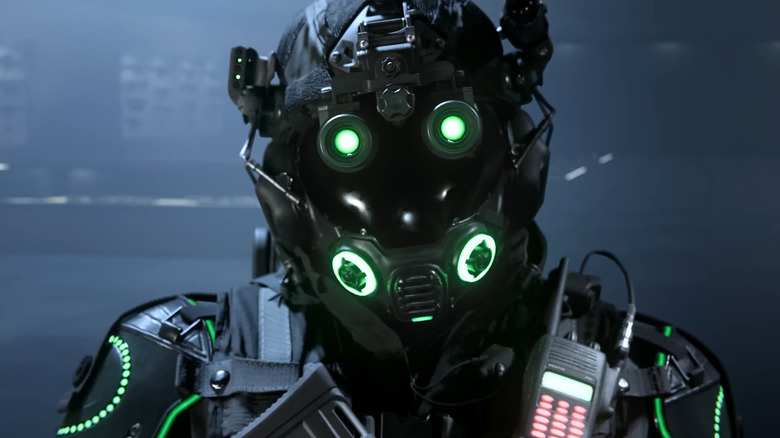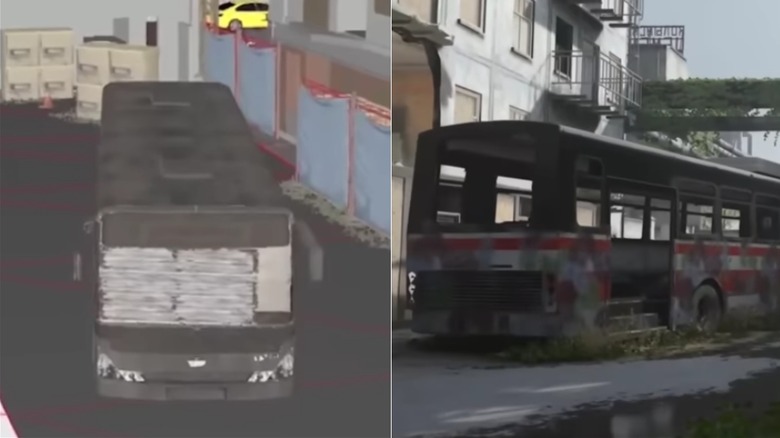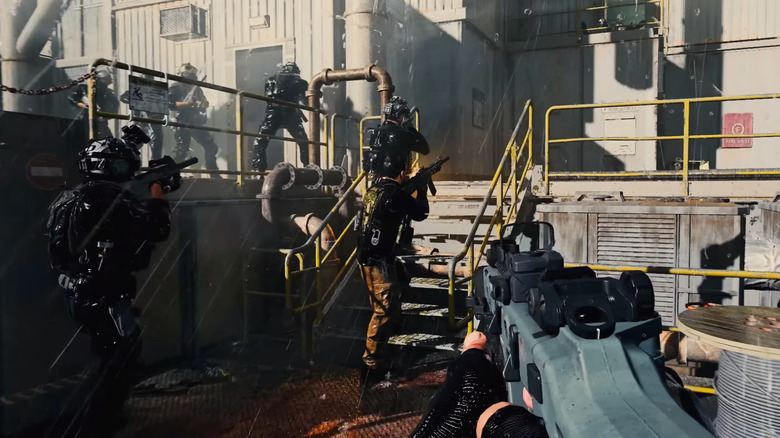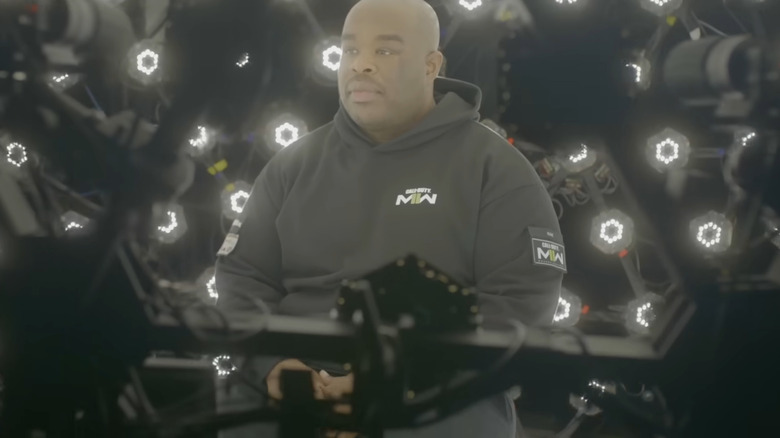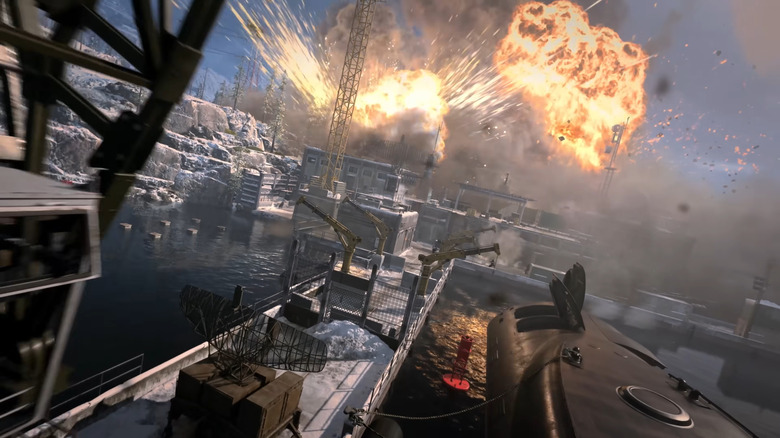What Call Of Duty Looks Like Without Special Effects
The "Call of Duty" franchise spans just over two whole decades at this point, but it was Infinity Ward's 2007 release of "Call of Duty 4: Modern Warfare" that arguably made it a household name. Since then, each annual release has innovated on a winning formula by utilizing the best in modern game development tech to create visceral storylines and addictive multiplayer modes. When the reboot of "Call of Duty: Modern Warfare" came out in 2019 with the biggest engine upgrade in the franchise's history, fans were blown away by the vastly improved gunplay and photorealistic graphics. This was clearly the beginning of a new era for "Call of Duty."
Since then, the franchise has seen further innovations, and the talented teams behind these new advances have been extremely forthcoming when it comes to sharing behind-the-scenes footage and the creative processes involved. Thanks to these peeks behind the curtain, it's very easy to see what "Call of Duty" would look like without the special effects — and it's safe to say it would not feel nearly as groundbreaking or immersive.
Performance capture
Performance capture (or P-Cap) for a "Call of Duty" title means invoking the intensity and accuracy of real-life military operatives in the filming space (also known as a "volume"). This is not an easy task, as there is often little to no visual context. Actors will need to provide a believable performance that translates well to cutscenes.
For this reason, "Call of Duty" motion capture scenes are often filmed under supervision of military advisers who guide the performance, dictating everything from weapon handling, movements in engagements, and even actors' facial expressions. These intricacies might take an animator forever to produce from scratch and might never reach the authenticity that can be realized with a combination of real-life actors and knowledgeable guidance.
The steps for P-Cap in a modern "Call of Duty" title begin with using photogrammetry to scan an actor's entire body from every conceivable angle (more on that later), then their movements and voice are captured in real time as they perform a scene in the volume. It's important to note that the actors do not always know the specific camera angle or how wide the shot will be in the final product. Because of this, the actors need to basically lose themselves in the characters to maintain the utmost authenticity. Barry Sloane, the actor who plays Captain Price in the "Modern Warfare" reboot, talks about this in a BTS interview, explaining that the performers must remained dialed-in at all times, regardless of which direction he or the camera may be facing.
Real-Time Visual Effects
When VFX are done right, you tend not to notice. When animation feels natural, it's a high mark of quality for games aiming at being gritty and real; your brain simply accepts what it sees. Achieving this level of visual fidelity is one of the major goals for the game engines used in the newer "Modern Warfare" titles. The engine utilized for 2019's "Call of Duty: Modern Warfare," IW 8.0, provided significant upgrades over previous entries. Its successor, IW 9.0, aimed to surpass everything that came before it in terms of visual quality. This goal was especially important during development, as the MW2 Engine/IW 9.0 is intended to essentially be the unified engine for all "Call of Duty" titles for the franchise going forward.
Some of the more impactful VFX of the new engine include the water effects on characters and objects, which give things an appropriately glossy sheen whenever they have been submerged or rained upon. Everything can get soaked and will take varying times to dry depending on the material. In line with this significant upgrade, effects for things like water, smoke, fire, blood, and explosions now include the use of volumetric particles. As explained by Infinity Ward VFX artist Patrick Hagar, "Instead of just having like these flat Sprites, which most of our effects have always been, we're mixing actual volumetric particles to help fill it out."
Audio
The sound effects for modern "Call of Duty" are captured from real world sources using the best technology available. In order to create maximum immersion and authenticity, many different takes are recorded for everything and adapted for every possible scenario the player can create. To this end, "Call of Duty" devs send sound-capturing teams out in the world to record live footage. Naturally, military bases are primary locations for this kind of work, allowing the developers to record the sounds of actual firearms and other military equipment. The devs will capture the sounds of weapons firing at various rates and distances, as well as reload sounds and even the clink of empty shell-casings landing on different surfaces.
As seen in behind the scenes footage from "Modern Warfare 2," the sound team was given access to everything from light machine guns to even rockets. Infinity Ward was also even given access to three types of helicopter and a tank. Aside from weapons discharging and vehicles revving, the team also takes down the sounds the various doors make, as well as what the terrain sounds like when you're inside a specific vehicle. All scenarios are accounted for.
In addition to tools of war, environmental sound effects are captured. These include the ambiance of military bases, the water behind a speed boat, and the sound of rain. By programming "emitters" into various parts of the level to disperse these sounds, the devs provide necessary ambient sounds that create maximum immersion for the player. "As you are walking by things you hear and feel the rain around you in a realistic way," explains "MW2" Senior Lead Audio Designer Dave Rowe.
Animation
While P-Cap/mo-cap helps to create third-person animations and any situation where you see a physical player character, first-person animations for 2019's "Call of Duty: Modern Warfare" were all hand-keyed. These include weapon-firing, reloading, and other actions the player character does from their own P.O.V. "Modern Warfare" animation director Mark Grigsby explained to Game Informer that newer "CoD" needs gritty and realistic animation. "We were going for ... this person that works and sleeps with his weapon non-stop, [and] handles it with extreme confidence," said Grigsby. To reach this goal, he and his team elected to forgo the mo-cap process and go for something with a bit more dramatic flair.
Grigsby also points out that even though rough animations may look great when rendering them with the Maya visual effects software, this is only one step in the process. There's a component of trial-and-error involved, in which the animator has to test the execution of a specific animation in-game to ensure that the feel and the look are nailed down. If it doesn't work as intended, then it's back to Maya to make the necessary adjustments.
Environmental Design
When designing an environment for "Call of Duty," especially multiplayer maps, there are many factors at play. First, it must look somewhat grounded within the game's universe and posses the same visual and graphical fidelity seen in the campaign/cutscene environments. Perhaps most important of all, it must allow for easy traversal and provide varied opportunities for fun battle scenarios. Once a concept for a map has been proposed and the overall theme has been locked down, the developers create a block-out of the map. This block out features the basic layout and overall look of the map. Once that has been finalized, it's up to the environmental artists to add textures, foliage, lighting, and all the other bells and whistles that sell the place as a believable environment.
One of the challenges faced in multiplayer environmental design is selling the theme of a map, such as an overgrowth of foliage, without providing too many opportunities for pesky campers to dominate a match. We can all agree there is nothing worse than a player in a ghillie suit going 30-0 because they've been hiding in a bush the entire round.
Characters
Capturing footage for a character involves many different steps, performance capture and photogrammetry are but two. A third important step is capturing the voice of a character and while voice-lines are done usually alongside mo-cap scenes, there is also other sounds that need extra special attention.
What differentiates video games from other media is the interactivity. Because players can perform a wide variety of physical actions such as running, climbing, jumping and getting hurt as many times as they want, there needs to be variety to the human sounds that accompany these actions.
To prevent characters from sounding repetitive, actors must perform take after take of various sounds, including every grunt, growl, and labored breath. It is an exhausting aspect to the job that is absolutely necessary in order to provide realism. Without these multiple recordings, things would start to sound very weird after a few hours with the game.
A.I
In a game that's meant to loosely simulate real combat engagements, you need combatants that react to your every move — and if they are on your side, you need them to value their life as much as you value your own. Before "Modern Warfare 2" the A.I. for NPCs was not they best, and companions did not value their lives as much as they should.
In "Modern Warfare 2" and beyond, A.I. has been hugely improved. A.I combatants will thoughtfully hunt you down, seek cover, and engage or disengage based on your actions. They will also attempt to anticipate your movements and try their best to survive whatever is thrown at them. Now the player no longer feels like they're fighting a bunch of brain-dead NPCs, but rather trained fighters that know how to turn things in their favor. Luckily, the same goes for your teammates in the story. The new A.I. model gives the player's companions a sense of urgency and place within the world, and they'll use the same survival tactics to help win the day. Without this A.I. engine, all players would see is enemies sitting in one spot and waiting to be taken out.
Photogrammetry
Before photogrammetry, props, characters and most other objects would have to be created entirely by hand by a talented 3D artist. The process includes not only designing the basic shape of an object, but all the intricate details such as wear and tear; a process that would normally take weeks.
Photogrammetry is a revolutionary technology that allows designers to essentially import images of actual physical props, costume elements, set pieces, and even characters from the real world and create a 1:1 3D model of that object. This process is made possible through the use of a special rig consisting of a cage with a platform in the middle. Mounted in the steel cage are cameras, all focused on the platform, each at a different angle. The cameras snap images of objects on the platform, getting every conceivable angle on film. Those snapshots are then fed into a computer and turned into a high-polygon 3D model. That model is then scaled down to run at the game engine's specific framerate. The result is a 3D object that is about as true-to-life as it gets.
Another really interesting part of this process is how objects are treated ahead of time. Many of the intricate details seen on costumes and props — such as weathering, damage, and normal wear and tear — are actually inflicted on the real-life object prior to being captured. The developers will often use various sanders and other tools to simulate distress in a thoughtful way.
Engine
Every aspect of the "Call of Duty" development process coalesces here. The game engine used for "Call of Duty" was originally a heavily modified version of the "Quake 3 Arena" engine, iD Tech 3. In the early 2000s, iD Tech 3 was renowned for its superior netcode and responsiveness during gameplay, making it an excellent foundation for the high-stakes multiplayer and cinematic single-player content in "Call of Duty." With the revamp of "Modern Warfare" in 2019, Infinity Ward created IW 8.0, an engine could handle better animation, lighting, texture streaming, photogrammetry, physics, and many more features. This new engine was immediately pushed to its limits, with Infinity Ward's Michal Drobot explaining, "we're making sure your experience is as realistic as possible. To make everything look cool isn't easy." But this was only the beginning.
With the release of "Modern Warfare 2," Infinity Ward aimed to build on these next-gen upgrades even further with IW 9.0, building off the foundation of its predecessor creating the gold standard engine for all "Call of Duty" titles going forward. As mentioned previously, IW 9.0 allows for physic-based fluid effects, dynamic AI, directional audio and much more, all while aiming for 60 FPS on multiple platforms. This engine was designed to remind all of us that the "Call of Duty" franchise aims to be a lead innovator in gaming tech.

